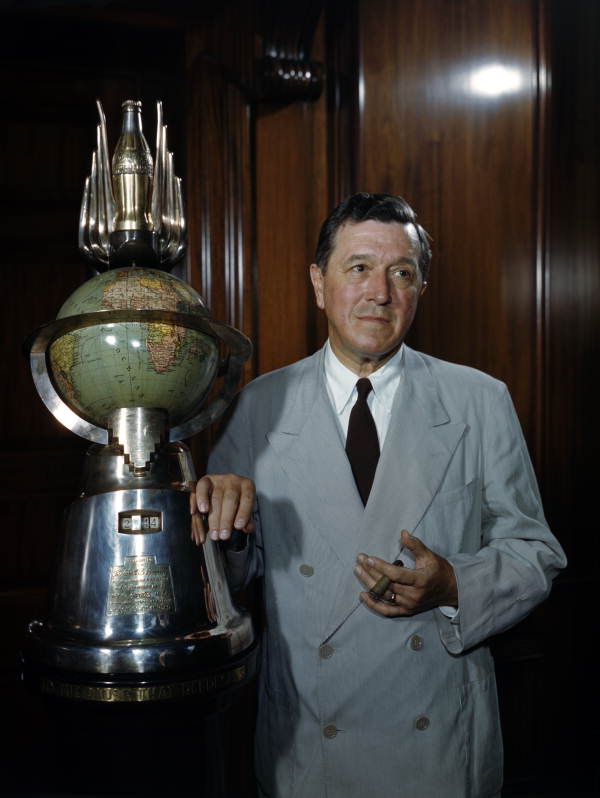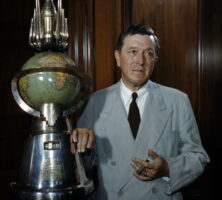SunTrust Banks, based in Atlanta, was the thirteenth largest bank in the United States before it merged with BB&T to become Truist Financial in 2019. From its beginning the bank earned a reputation as a trust for well-to-do clients, but it also played a crucial role in recapitalizing regional investment. The stability and growth of the bank, which maintained branches and affiliates in seven states and the District of Columbia, served as a measurement for the economic growth of the New South.
Early History
SunTrust was the hybrid of several southern banks, but its oldest Georgia ancestor is the Commercial Travelers’ Savings Bank, founded in 1891 by Atlanta businessman Joel Hurt. Two years later Ernest Woodruff, then a board member, urged that the savings bank be reorganized as a trust and investment bank. The institution was duly renamed the Trust Company of Georgia, a title that would remain more or less unchanged until the 1990s.
Ernest Woodruff, a native of Columbus, assumed the presidency of the Trust Company in February 1904. This frugal son of a northern mill owner had a galvanizing effect on the young bank. Under Woodruff the company orchestrated a series of mergers that secured the bank’s position. In 1910 he arranged the merger, for $3.5 million, of several small regional coal and ice companies to form the Atlantic Ice and Coal Company, which was the largest underwriting venture in Georgia history to that point. Within the same decade the bank engineered the reorganization of Atlanta Steel Company to Atlantic Steel and acquired the Empire Cotton Oil Company. In 1926 the Trust Company acquired the Continental Gin Company.
These ventures, however, were only the prelude to a larger, more historic venture. In 1919 Woodruff secured the underwriting of the first publicly traded stocks of Asa Candler’s Coca-Cola Company. The deal, brokered by Woodruff, left the bank in possession of what would become more than 48 million shares of the Atlanta beverage company. The two institutions continued to work together, a relationship enshrined in SunTrust’s sometime nickname, “the Coca-Cola bank.” In 1922 Woodruff gave up the presidency to become chairman of the board for the bank. The following year his son, Robert Woodruff, became the president of Coca-Cola, a position he held until 1955. At the time of its merger with BB&T, SunTrust still held the only written copy of the original Coca-Cola formula in a vault at its main office in Atlanta.

Twentieth Century Growth
During the 1920s the Trust Company participated in three mergers. In 1923 the bank merged with Lowry National Bank, which had bought the Trust Company’s commercial banking operation in 1907, and the new company was called Lowry Bank and Trust Company. In 1924 this new company merged with Atlanta National Bank to become Atlanta and Lowry National Bank. In 1929 Atlanta and Lowry merged with Fourth National Bank. The resulting entity, First National Bank, was broken up by the passage of the Banking Act of 1933, also known as the Glass-Steagall Act, which left the Trust Company as a wholly independent institution for the first time in more than ten years.
From that point forward the bank began a dependable record of growth. By the mid-1930s it had absorbed banks in five of the largest Georgia cities outside Atlanta—Augusta, Columbus, Macon, Rome, and Savannah. In the years following World War II (1941-45) the bank continued its expansion, culminating with the construction of Trust Company Tower in 1969 at Pryor Street and Auburn Avenue in Atlanta, near the site of the original Trust Company Building.
The bank’s most substantial structural changes occurred during the period 1980 to 2000. Merging in 1985 with SunBanks of Florida, the new entity acquired the Third National Corporation, then the second-largest bank-holding company in Tennessee. By 1995, doing business under the name SunTrust, the institution pursued a series of major acquisitions, including the purchase of Crestar Financial Corporation in 1998, which extended SunTrust into Virginia, Maryland, and the District of Columbia.
This largely successful series of acquisitions was marred in May 2001, when chair and chief executive L. Phillip Humann led SunTrust to make an unsolicited bid of $14.7 billion for the North Carolina–based Wachovia Corporation. The bid itself was sudden, attempted primarily as a last-minute means of blocking a merger between the bank’s two powerful rivals, Wachovia and First Union. Throughout the summer of 2001, in a contest that would cost both banks millions of dollars in advertising and legal fees, First Union and SunTrust tried to woo Wachovia shareholders. In the end SunTrust was unable to prevent the proposed merger, and shareholders at Wachovia voted in early August 2001 to accept the First Union bid. In December of 2019, SunTrust Banks completed a merger with BB&T, making the resulting company, named Truist, the sixth largest commercial bank in the United States.
Historically, SunTrust was a trust company—that is, it administered the wills and legacies of a typically wealthy clientele. But it also served as a lender to and an investor in large business ventures, making available large-scale credit to businesses while the South was predominantly rural. In this capacity SunTrust, like many large banks, came to be regarded as a quasi-public institution. In its early years particularly, the Trust Company played a critical role in recapitalizing the South, which, even four decades after the end of the Civil War (1861-65), still discouraged investment with prohibitive restrictions on lending. The company’s absorption of other banks during the Great Depression of the 1930s offered a degree of statewide stability to an industry that was faltering nationally. As the South formed an industrial base after World War II, the bank diversified by taking on the critical accounting functions of such larger industrial firms as the Southern Company and the young Dalton Carpet.
Individual officers of the bank enjoyed a close relationship with the city of Atlanta. The Woodruff family, apart from its relationship with Coca-Cola, has been the patron of several philanthropic causes, most visibly on the campus of Emory University. John A. Sibley, chair of the board from 1946 to 1963, was called on by Governor Ernest Vandiver in 1960 to lead a series of hearings—the so-called Sibley Commission of 1960-61—that encouraged a limited integration of Georgia public schools.





